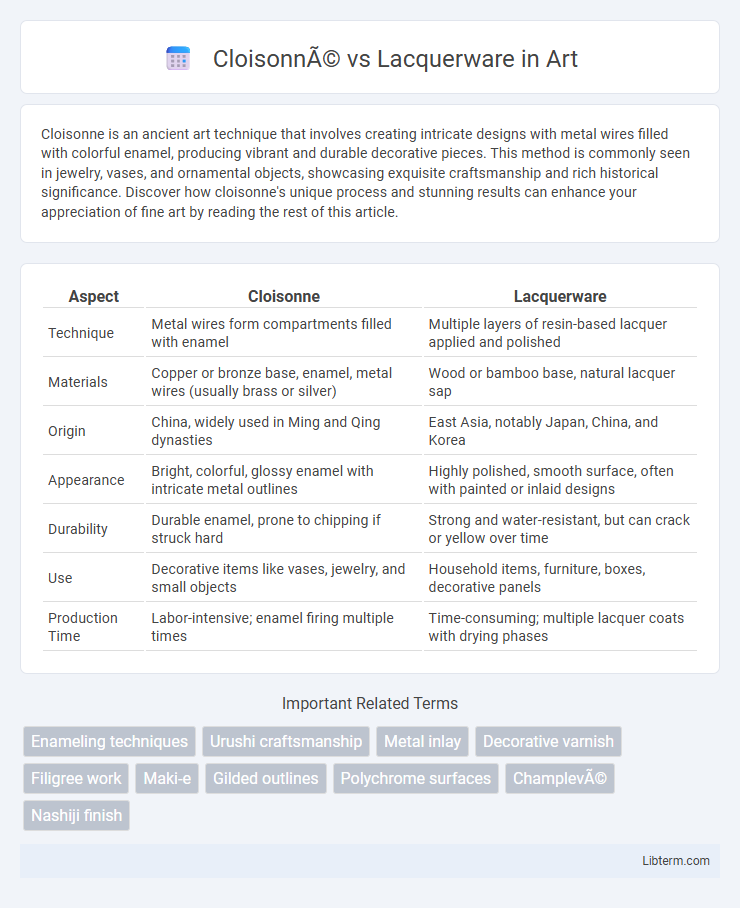Cloisonne is an ancient art technique that involves creating intricate designs with metal wires filled with colorful enamel, producing vibrant and durable decorative pieces. This method is commonly seen in jewelry, vases, and ornamental objects, showcasing exquisite craftsmanship and rich historical significance. Discover how cloisonne's unique process and stunning results can enhance your appreciation of fine art by reading the rest of this article.
Table of Comparison
| Aspect | Cloisonne | Lacquerware |
|---|---|---|
| Technique | Metal wires form compartments filled with enamel | Multiple layers of resin-based lacquer applied and polished |
| Materials | Copper or bronze base, enamel, metal wires (usually brass or silver) | Wood or bamboo base, natural lacquer sap |
| Origin | China, widely used in Ming and Qing dynasties | East Asia, notably Japan, China, and Korea |
| Appearance | Bright, colorful, glossy enamel with intricate metal outlines | Highly polished, smooth surface, often with painted or inlaid designs |
| Durability | Durable enamel, prone to chipping if struck hard | Strong and water-resistant, but can crack or yellow over time |
| Use | Decorative items like vases, jewelry, and small objects | Household items, furniture, boxes, decorative panels |
| Production Time | Labor-intensive; enamel firing multiple times | Time-consuming; multiple lacquer coats with drying phases |
Introduction to Cloisonné and Lacquerware
Cloisonne is a decorative art technique involving metal wires shaped into intricate patterns and filled with enamel to create vibrant, durable designs, often seen in jewelry and ornamental objects. Lacquerware utilizes layers of natural resin applied to wood or metal surfaces, producing a glossy, protective finish that can be intricately painted or inlaid for decorative purposes. Both crafts have ancient origins and are prized for their detailed artistry and cultural significance across regions like China and Japan.
Historical Origins of Cloisonné
Cloisonne originated in the Byzantine Empire around the 6th century and later flourished in China during the Ming and Qing dynasties, becoming a highly prized decorative art form. This technique involves creating intricate designs with metal wires (cloisons) filled with enamel and then fired to produce vibrant, durable surfaces. Unlike lacquerware, which relies on layers of sap-based coatings, cloisonne showcases complex metalwork combined with colorful enamel for ornate jewelry, vases, and other art pieces.
Historical Development of Lacquerware
Lacquerware originated over 7,000 years ago in ancient China, where natural sap from lacquer trees was used to create durable, glossy finishes on wooden objects, evolving into a sophisticated art form during the Shang and Zhou dynasties. The technique spread across East Asia, influencing Japanese, Korean, and Southeast Asian decorative arts, with each region developing unique styles such as Japan's maki-e and Korea's ottchil. Historical developments in lacquerware reflect advancements in craftsmanship, materials, and cultural symbolism, making it a pivotal medium for both utilitarian and ceremonial objects throughout Asian history.
Materials and Techniques: Cloisonné
Cloisonne uses metal wires or strips to create compartments on a metal object, which are then filled with colored enamel paste. The technique involves firing these compartments at high temperatures to fuse the enamel, followed by polishing to achieve a smooth surface. Materials primarily include copper or bronze bases, with glass-based enamel providing vivid, durable colors.
Crafting Process: Lacquerware Explained
Lacquerware crafting involves applying multiple thin layers of sap from lacquer trees onto wood or metal surfaces, each layer requiring careful drying and polishing to achieve a glossy, durable finish. The process includes intricate hand-painting or inlay work, often using gold, silver, or mother-of-pearl to enhance the decoration. Unlike cloisonne, which uses metal wires to create compartments for enamel, lacquerware depends on the natural resin's protective and aesthetic qualities built up through labor-intensive layering and curing.
Distinctive Aesthetic Features
Cloisonne showcases intricate metalwork with vividly colored enamel separated by fine metal wires, creating raised patterns that emphasize texture and brilliance. Lacquerware features smooth, glossy surfaces achieved through multiple layers of lacquer, often adorned with delicate inlays or painted motifs, highlighting a sleek and polished appearance. The distinct tactile contrast between the raised enamel of cloisonne and the seamless finish of lacquerware defines their unique aesthetic identities.
Cultural Significance and Symbolism
Cloisonne and lacquerware both hold deep cultural significance in Asian art, with cloisonne often symbolizing wealth, longevity, and spiritual harmony through its intricate enamel designs bound by metal wires. Lacquerware embodies preservation and elegance, frequently featuring motifs representing nature, prosperity, and protection, reflecting centuries-old craftsmanship traditions. Each art form serves as a cultural artifact that conveys historical narratives and social values through its distinctive symbolism and aesthetic techniques.
Geographic Centers of Production
Cloisonne production is historically centered in Jingdezhen, China, renowned for its fine porcelain and enamel craftsmanship, as well as in Japan's Kyushu region, noted for intricate wirework designs. Lacquerware is predominantly associated with Southeast Asian countries like Vietnam, Thailand, and Myanmar, where the application of multiple layers of lacquer on wood or bamboo is a traditional art form. Both crafts reflect the unique cultural and geographic influences of their primary production centers, highlighting distinct materials and techniques endemic to each region.
Collecting and Valuing Cloisonné vs Lacquerware
Collecting cloisonne involves assessing the quality of metalwork, intricate enamel designs, and the age of the piece, which often increases its value, especially with antique Chinese or Japanese examples. Lacquerware's value hinges on the complexity of lacquer application, rarity of motifs, and provenance, with older, well-preserved Asian lacquerware generally commanding higher prices. Market demand, condition, and authenticity remain crucial factors in valuing both cloisonne and lacquerware collections, attracting collectors interested in East Asian decorative arts.
Contemporary Applications and Trends
Cloisonne and lacquerware have gained renewed popularity in contemporary interior design and fashion accessories, with artisans blending traditional techniques with modern aesthetics. Cloisonne's vibrant enamel colors and metalwork are favored in high-end jewelry and decorative objects, while lacquerware's sleek, polished surfaces and durability are prominent in luxury furniture and tableware. Both crafts benefit from sustainable sourcing and technological innovations, driving trends toward eco-friendly production and customizable, limited-edition collections.
Cloisonné Infographic

 libterm.com
libterm.com